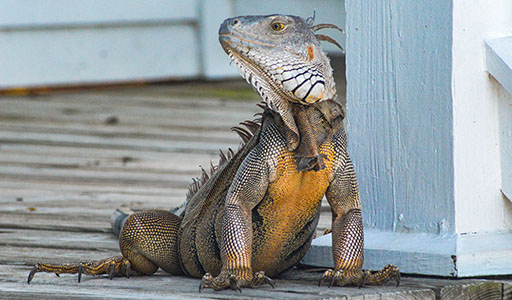Iguanas

Iguana Information
Coveted pets due to their docile natures and exotic appearances, green iguanas, sometimes referred to as common iguanas, slowly gained a presence in the U.S. as a result of the pet trade. Thanks to a combination of escaped iguanas and owner negligence, the South and Central American natives now thrive in distinct climates in the Nearctic region. Though large and awkward-looking, green iguanas are deceivingly agile and have the ability to climb trees easily or make haste on the ground. In addition to their classification as invasive pests, iguanas are widely disliked due to their destruction of landscaping and disease transmission.

What does a Iguana look like?
Iguanas have claws, tails, four legs, and long, leathery bodies. The lizards possess distinctive back spines, dewlaps that hang beneath their chins, and sharp teeth designed for tearing vegetation. Although the species is called the green iguana, they can be a wide range of colors including light blue, pink, and orange. Large lizards compared to most, iguanas grow between 4 and 6 feet in length, including their tails, and weigh about 11 pounds on average. Some have been reported to weigh as much as 18 pounds.

What does a Iguana eat?
The lizards are known for their vegetarian inclinations. However, iguanas occasionally eat insects and small animals, as well. Favorite foods include mosses, leafy greens, and various fruits.

Iguana habitats
Populations of the green iguana can be found in south Florida, Hawaii, and in the Texas Rio Grande Valley. The animals can only live in climates like those found in humid tropical rain forests. Arboreal creatures, iguanas prefer trees for shelter and enjoy plentiful, edible vegetation and nearby water sources.
Iguana Tracks
Foot and tail prints are common signs that an iguana has been in the yard. Iguana tracks are distinct from those left by other reptiles because of their size and appearance. Much larger than geckos or anoles yet smaller than alligators, these pests may reach five or six feet in length and weigh between 10 and 20 pounds. Most visible in mud or sand, their tracks consist of five-toed footprints surrounding a line made as their straight tails drag the ground.
Iguana Movements
Preferring to live in trees, iguanas spend much of their time sunning themselves. The reptiles are also excellent swimmers and commonly found near water. In fact, iguanas are known to evade predators by diving head first from tree branches into nearby bodies of water. They may also descend from trees to dig burrows for eggs and forage for food. Since iguanas are adaptable and adjust well to open spaces, residential lawns are not off limits. The pests are quite agile and quick while on the ground, making their presence in yards unnerving to many homeowners.

